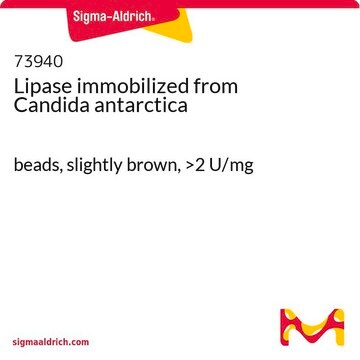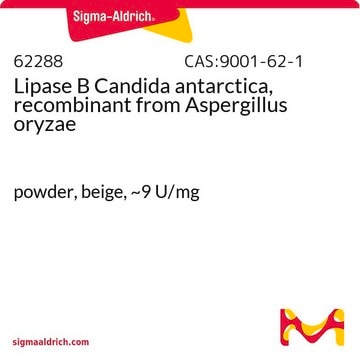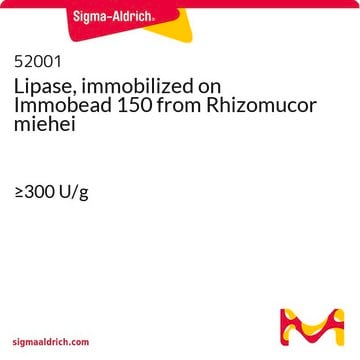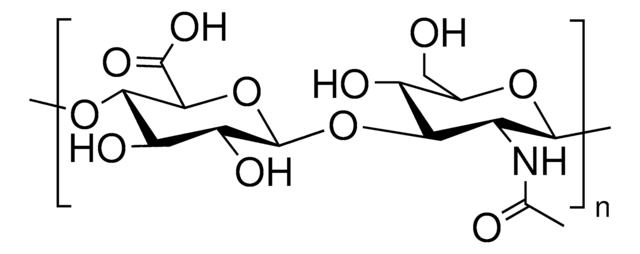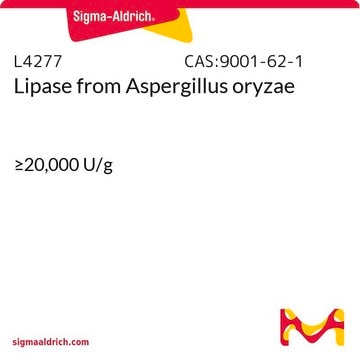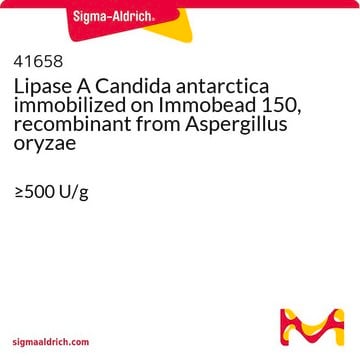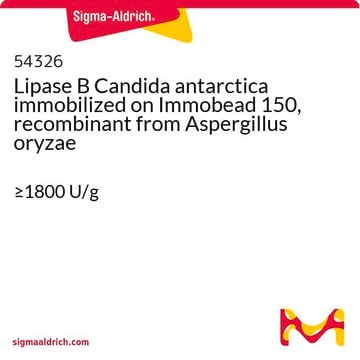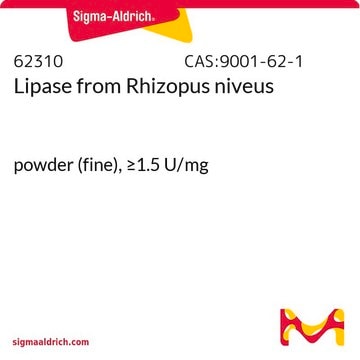76546
Lipase, immobilized on Immobead 150 from Thermomyces lanuginosus
≥3000 U/g
Synonyme(s) :
Immobilized lipase, Lipase enzyme
Se connecterpour consulter vos tarifs contractuels et ceux de votre entreprise/organisme
About This Item
Code UNSPSC :
12352204
Nomenclature NACRES :
NA.54
Produits recommandés
Source biologique
fungus (Thermomyces lanuginosus)
Forme
powder (or beads)
Activité spécifique
≥3000 U/g
Technique(s)
analytical sample preparation: suitable
Couleur
white to off-white
Application(s)
life science and biopharma
Température de stockage
2-8°C
Description générale
Research area: Cell Signaling
Lipase from Thermomyces lanuginosus (TLL) is a basophilic, single-chain protein and thermostable enzyme. It belongs to the alpha/beta-hydrolase fold family. TLL is roughly spherical and is made up of a central seven-stranded β-parallel sheet with five interconnecting α-helices.
Lipase from Thermomyces lanuginosus (TLL) is a basophilic, single-chain protein and thermostable enzyme. It belongs to the alpha/beta-hydrolase fold family. TLL is roughly spherical and is made up of a central seven-stranded β-parallel sheet with five interconnecting α-helices.
Application
Lipase, immobilized on Immobead 150 from Thermomyces lanuginosus has been used:
- as a biocatalyst to study ultrasound-assisted transesterification of a blend of non-edible oils with methanol.
- as a catalyst in the synthesis of medium chain fatty acids (MCFA) and polyunsaturated fatty acids (PUFA) rich oils by enzymatic structuring of flax seed oil.
- for the resolution of chiral compounds and the transesterification production of biodiesel.
- to enhance the efficiency and selectivity of the enzymatic synthesis of ethyl-(R)-2-hydroxy-4-phenylbutyrate, (R)-HPB ester.
- to facilitate a chemoenzymatic process for the continuous synthesis of (S)-7-((tert-Butyldiphenylsilyl)oxy)hept-1-yn-4-ol, a crucial intermediate for Eribulin synthesis, within a packed-bed reactor setup.
Actions biochimiques/physiologiques
It participates in catalyzing the hydrolysis of triglycerides at the water-lipid interface and produces mono-, di-glycerides, and free fatty acids. Due to its versatility, this enzyme is applicable in various industries including, detergents, paper, leather, baking, fine chemicals, fuel, and biocatalysts.
Lipases catalyze the hydrolysis of triacylglycerols into glycerol and free fatty acids.
Définition de l'unité
1 U corresponds to the amount of enzyme which liberates 1 μmol butyric acid per minute at pH 7.5 and 40°C (tributyrin, Cat. No. 91010, as substrate)
Code de la classe de stockage
11 - Combustible Solids
Classe de danger pour l'eau (WGK)
WGK 3
Point d'éclair (°F)
Not applicable
Point d'éclair (°C)
Not applicable
Équipement de protection individuelle
Eyeshields, Gloves, type N95 (US)
Faites votre choix parmi les versions les plus récentes :
Déjà en possession de ce produit ?
Retrouvez la documentation relative aux produits que vous avez récemment achetés dans la Bibliothèque de documents.
Les clients ont également consulté
Chemoenzymatic Process for the Preparation of (S)-7-((tert-Butyldiphenylsilyl)oxy)hept-1-yn-4-ol in a Continuous Packed-Bed Reactor, a Key Intermediate for Eribulin Synthesis
Krishna AS, et al.
Organic Process Research & Development, 24(11), 2657?2664-2657?2664 (2020)
An improved process for the preparation of ethyl-(R)-2-hydroxy-4-phenylbutyrate, (R)-HPB ester by lipase from Thermomyces lanuginosus
Basetty S, et al.
bioresource technology reports, 101163-101163 (2022)
Study of Thermomyces lanuginosa Lipase in the Presence of Tributyrylglycerol and Water
Santini S, et al.
Biophysical Journal, 96(12), 4814?4825-4814?4825 (2009)
Notre équipe de scientifiques dispose d'une expérience dans tous les secteurs de la recherche, notamment en sciences de la vie, science des matériaux, synthèse chimique, chromatographie, analyse et dans de nombreux autres domaines..
Contacter notre Service technique
